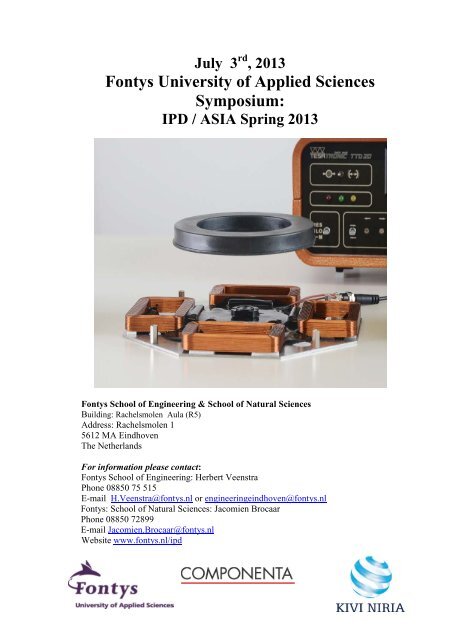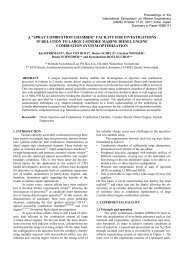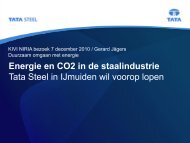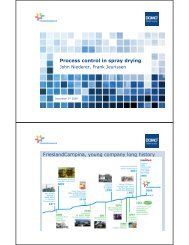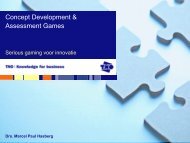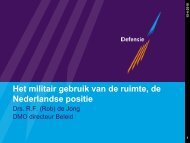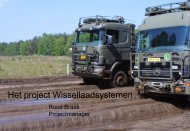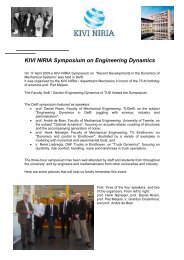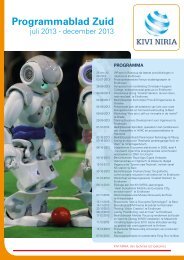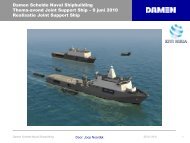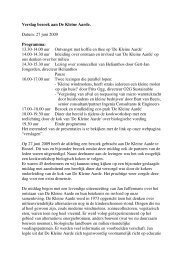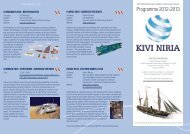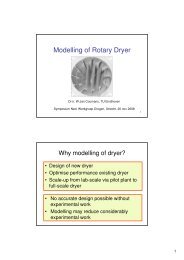Programme IPD/ASIA Symposium - Home - kivi niria
Programme IPD/ASIA Symposium - Home - kivi niria
Programme IPD/ASIA Symposium - Home - kivi niria
Create successful ePaper yourself
Turn your PDF publications into a flip-book with our unique Google optimized e-Paper software.
Key note speaker:Gavin Proctor,Design manager, Front End Innovation, Philips Group DesignAbout PhilipsRoyal Philips of the Netherlands is a diversified health and well-being company, focused onimproving people’s lives through meaningful innovation in the areas of Healthcare, ConsumerLifestyle and Lighting. Headquartered in the Netherlands, Philips posted 2012 sales of EUR24.8 billion and employs approximately 118,000 employees with sales and services in morethan 100 countries. The company is a leader in cardiac care, acute care and home healthcare,energy efficient lighting solutions and new lighting applications, as well as male shaving andgrooming, home and portable entertainment and oral healthcare.About Philips DesignPhilips Design is one of the largest design organizations in the world; a creative force of some400 professionals, representing over 35 different nationalities located in 7 studios in Europe,Asia and North America. We win more than 50 design awards each year. In addition toserving the whole of Philips design needs we deliver to a diverse client roster of 60 Fortune500 companies.At Philips Design, we know we can only fulfil people's needs and desires when we trulyunderstand what they are. That’s why we always begin with getting to know as much as wepossibly can about our target audiences: their priorities, values, inspirations, likes anddislikes.With this insight, our international, multi-disciplinary and diverse design team is able todeliver truly relevant solutions that anticipate people's needs, exceed their expectations andenhance our customers' business success.Summary of presentationLooking back 28 years ago when I graduated from university and entered Philips as aprofessional industrial designer, I realize now that my studies had equipped me with thenecessary skills to practice being a designer – what I like to think of today as the “how” ofdesign, the process of developing ideas into concepts, giving form, defining, shaping,specifying and detailing my designs, and ultimately working alongside mechanical designersand engineers to realize mass produced products – playing my part of what I eventually cameto know as the Integrated Product Development (<strong>IPD</strong>) process within Philips. Forapproximately half of my professional career I have been closely involved in the activitiesdesign ideation, creation and realization which make up the designers role within <strong>IPD</strong>.Throughout the second half of my career so far however, I have been involved in something2
The KIVI NIRIA AWARDKIVI NIRIA wants to congratulate all the students who have successfully completed theirproject today. KIVI NIRIA is the Royal Dutch organization for Engineers and Engineeringstudents. An organization with a broad and dynamic network where knowledge andexperience from different engineering disciplines come together.KIVI NIRIA has approximately 25.000 members and initiates, supports, facilitates andorganizes approximately 600 events per year. Promotion of Engineers, Technique andTechnology by means of knowledge sharing and networking is a primary task of KIVINIRIA. A must for every Young Professional to find his or her way in the world ofEngineering.As such we are also very interested in what the future engineers of Fontys University ofapplied science are achieving in their projects.We are proud and enjoy that we can be present today during the presentations of yourprojects. This year KIVI NIRIA made a 2013 prize available for the best project. A juryconsisting of KIVI NIRIA engineers has reviewed the projects and selected the best projectfrom the symposium of the 30th of January 2013 and the best project of today’s symposiumon the 3th of July 2013.Today the team members of the overall winning project will be Rewarded with the KIVINIRIA AWARD 2013..From KIVI NIRIA SouthMr. Eric PersoonMr. Ricardo Abdoelwww.<strong>kivi</strong><strong>niria</strong>.nl4
<strong>Programme</strong> <strong>IPD</strong>/<strong>ASIA</strong> <strong>Symposium</strong>Wednesday July 3 rd , 2013Fontys School of Engineering building R510.00 hrs Registration and coffee Foyer R510.30 hrs Welcome Herbert Veenstra, chairman of the day Aula R510.40 hrs Key note speaker: Gavin Proctor, Aula R5Design manager, Front End Innovation, Philips Group DesignTitle: What <strong>IPD</strong> looks like within Philips and how it fits into the biggerprocess of Business Creation11.15 hrs Split up to parallel sessionsRoom 0.22 Aula Room 0.2311.20 hrs <strong>IPD</strong> 12 <strong>IPD</strong> 10 <strong>ASIA</strong> 24Sustainable dance floor Wound Retractor Acoustic Feedback simulator11.55 hrs <strong>IPD</strong> 13 <strong>IPD</strong> 2 <strong>ASIA</strong> 23Electromagnetic Elevator ASML Light projector loudspeaker Enclosure12.30 hrs Break: Lunchtime &demonstrations Foyer R513.05 hrs <strong>IPD</strong> 17 <strong>ASIA</strong> 22Digital radioAutomated truck tire control13.45 hrs <strong>IPD</strong> 5 <strong>IPD</strong> 6 <strong>ASIA</strong> 19Remote C Scent system Hoverbike front rotorsQuantum Entanglement14.20 hrs <strong>IPD</strong>18 <strong>IPD</strong> 7 <strong>ASIA</strong> 20Child distance watcher Hoverbike Frame design IR-panels for Heating14.55 hrs Break: Foyer R515.30 hrs <strong>IPD</strong> 9 <strong>IPD</strong> 3 <strong>IPD</strong> 4Swimming pool Automated soap powder dispenser Demo FurnaceIntelligent floor16.05 hrs <strong>IPD</strong> 11 <strong>IPD</strong> 15 <strong>IPD</strong> 1Starting block Floor welding robot Persian Dutch windmill16.40 hrs End of presentations16.45 hrs KIVI NIRIA AWARD Aula R516.55 hrs Closing and “collaborative” drink Foyer RSponsored by:18.00 hrs End5
Project <strong>IPD</strong> 1 Persian Dutch WindmillOrganization Scheepers Beheer BVCompany contact H.ScheepersFontys Tutor H.VeenstraTeam membersStudents Institute DepartmentGuilherme Augusto RibeiroTavares de Almeida do Almaral Fontys School of Engineering Electrical & Electronic EngineeringFrederico Schmaltz de Andrade Fontys School of Engineering Mechatronics EngineeringDayna Every Fontys School of Natural Sciences Engineering PhysicsHans Heinen Fontys School of Engineering Mechatronics EngineeringThibault Passade Fontys School of Engineering Electrical & Electronic EngineeringStefano Pescarolo Fontys School of Engineering Mechanical EngineeringGuilherme Henrique Prevedello Fontys School of Engineering Electrical & Electronic EngineeringTom Verstraaten Fontys School of Natural Sciences Engineering PhysicsBrief description of the project:1000 years ago the Persians built windmills based on the principle shown below and a picture of theinnovative redesign of the windmill.Figure 1. Persian windmillFigure 2. Windmill design <strong>IPD</strong>1The wind blows from one direction on a building with an opening in the wall, where the air iscompressed and passes through and hits the rotors of a fan. The fan rotates, generating usable energy,which is converted to electrical energy. The generated electrical energy can be used for severaldifferent purposes.The main problem of the construction is based on the fact that the wind has to come from one specificdirection. By having the wind blowing right in the direction of the intake, the maximum output powerwould be generated. Since the wind does not blow in one singular direction, a lower output power willbe generated.The modern ordinary windmills have their own disadvantages: a lot of noise and a rotating shade onthe ground, implying in a loss of power. Other negative factor about windmills is the implied visualpollution they have altogether with the danger for flying animals. Because of the noise and shade, theycan only be built in areas with a low or no population degree, i.e. at the sea.Mister Scheepers has come up with the idea to make a combination of a Persian and a Dutch windmill.The purpose of the project is to research and build the best possible windmill, which can be used in anurban environment.After all the calculations and experimentations are done, a conclusive result may be obtained with thefinal prototype of the Persian-Dutch Windmill. A real world sized windmill may show differentbehavior from the discussed prototype.6
Project <strong>IPD</strong> 2Organization De OntdekfabriekCompany LogoCompany contact Hugo VrijdagCoach Fontys Joost van StraalenTeam membersStudents Institute DepartmentMark van de Goor Fontys School of Engineering Mechanical engineeringJoost van Zeeland Fontys School of Engineering Mechanical engineeringMark de Groot Fontys School of Engineering Electrical engineeringNiels van Dijk Fontys School of Natural Sciences Engineering PhysicsRuud de Zwart Fontys School of Natural Sciences Engineering PhysicsYbe Dijkstra Fontys School of Engineering Electrical engineeringDescriptionThe goal of this project is to develop a demonstration model for the Ontdekfabriek, to demonstrate thetechnology that is used in the ASML machines to manufacture chips.The Ontdekfabriek is an institute which tries to motivate en inspire children into technology. TheOntdekfabriek consists of different programs where children get to meet with different kinds oftechnology. The demonstration model that will be produced for the Ontdekfabriek inspires children tothe technologies used in the ASML machines, worked in to a game. In this game, children create a“fake” chip which controls a G-sensor. To accomplish this, children have to work together with a lightsource, lenses and mirrors to recreate the lithography process on bigger scale. While performing this,children will obtain knowledge of the process in ASML machines.7
ProjectOrganization<strong>IPD</strong> 3 Development of automated powder dispenserHigh HygieneTeam members:Company logoCompany contact T.EllermannFontys Tutor Harrie BronnebergStudents Institute DepartmentGabriela Prado da Silva Fontys School of Engineering Electrical engineeringGustavo Dias Cardoso Fontys School of Engineering Electrical engineeringIsrael Garcia Chagas Fontys School of Engineering Mechanical engineeringJude Chukwuemeka Anizoba Fontys School of Engineering Electrical engineeringMaarten Rethmeier Fontys School of Engineering Mechanical engineeringRafael Cintra Vasquez Fontys School of Engineering Mechanical engineeringBrief description of the projectOur project is going to be developed for the company HighHygiene BV. HighHygiene BV is acompany with sustainable hygiene solutions, that provide high hygiene services at the lowest energycost.The company already has a device that makes soap powder from a soap bar, so the group already hasthe basic dispensing techniques. Now it is necessary to develop a soap dispenser that does the same,but automatic. This means that the soap powder should fall down without touching the device.The prototype must be able to dispense powder in constant small portions, triggered by movement of ahand, whilst using the minimum on battery power. The device must not use much energy, andrechargeable batteries are preferred.The main idea is to upgrade the existing company device, since some ideas of the current mechanismare very practical, cheap and easy to implement. The difficult part will be to develop the system thatactivates the grinder automatically. The electrical engineers in the group are thinking of using aninfrared sensor to activate a motor. This will make the grinder spin and cut the soap.8
ProjectOrganizationCompany contactFontys Tutor<strong>IPD</strong> 4 Demo FurnaceLiebrand ConsultancyCees BlokhuizenTeam membersStudents Institute DepartmentTiago Martins Fontys School of Engineering EngineeringDavid Mambre Fontys School of Engineering EngineeringJoep Stewart Fontys School of Natural Sciences Engineering PhysicsLuuk van Gils Fontys School of Natural Sciences Engineering PhysicsDescriptionThe project is about a Lehr oven. A oven for the annealing of glass.Rapid cooling of molten glass generates an uneven temperature distribution in the body of the glasswhich results in mechanical stress sufficient to cause cracking before the object has reached ambienttemperature, or to result in susceptibility to cracking in later use, often resulting from thermal shock.To prevent this, objects manufactured from molten glass are annealed by cooling gradually in a lehrfrom a temperature just below the solidification point of the glass. Anneal cooling rate depends on thethickness of the glass, and can range from several tens of degrees Celsius per hour for thin sections toa fraction of a degree Celsius per hour for thick slabs or castings.In the early stage of this project a small research is done on how to downscale a Lehr oven and theeffects because of downscaling. But he main part of the project is about how to improve the energyefficiency of the Lehr oven.9
Project <strong>IPD</strong> 5 Modular Scent UnitOrganization Philips HealthcareCompany contact Ir. W. van GroningenCoaches Ir. P. van KollenburgTeam members:Students Institute DepartmentTom Broekmans Fontys School of Engineering Electrical EngineeringTom Bosmans Fontys School of Engineering Electrical EngineeringKoen Ederveen Fontys School of Engineering Electrical EngineeringJiahang Su Fontys School of Engineering Electrical EngineeringKristovorus Ivan Fontys School of Engineering Mechatronics EngineeringSamantha Coimbra Limonge Fontys School of Engineering Mechatronics EngineeringDescriptionWhen patients have to be scanned by a MRI or CT scanner, they can be nervous to enter thesescanning machines. To prevent this fear, an Ambient Experience system with light, animations andsound technologies has been developed. The combination of light, animation and sound is called atheme. The patient can select one of several predefined themes. A missing element of those themes isscent.The problem that is described above is the motivation for Philips to do research on how this could beimplemented. In a joined venture between Philips Healthcare and Fontys University of AppliedSciences Eindhoven, the goal is to research and develop a modular scent system that can be used in awide variety of environments. The environments can be home application, shops, hospitals etcetera..Assignment: The assignment is to design a fully functional prototype of a modular scent system• Design of the complete system focusing on cost reduction- PCB design;- cost effective, producible housing.• Create a user friendly application for Android to control the modular scent system10
Project:Clients:CTOFontys tutor:<strong>IPD</strong> 6 Hover bike – Front rotor.Daedalus projectSander van Gameren, CEO Jesper SachtelebenGerben TigchelaarTeam members:Students Institute DepartmentGabriël Coelho do Amaral Fontys School of Engineering Mechatronics EngineeringJarno van de Giessen Fontys School of Natural Sciences Engineering PhysicsJaqueline Matos de Paula Fontys School of Engineering Mechatronics EngineeringNoud Mooren Fontys School of Engineering Mechatronics EngineeringGuido van Mullekom Fontys School of Engineering Mechatronics EngineeringMartijn Peeters Fontys School of Natural Sciences Engineering PhysicsAssignment: Designing and creating two functional electronically driven ducted propellers, whicheventually need to generate enough lift for a 30 kg hover-bike model. The propellers need to becontrolled by an arduino circuit which receives a desired thrust request from the main controlinterface. The controller initiates the spinning of the propeller and constantly controls the velocity ofthe propeller.The below picture is a comparable setup for our project goal.Source: http://www.etotheipiplusone.net/?p=81111
ProjectOrganizationCompany Logo<strong>IPD</strong> 7 Hoverbike - FrameDaedalusCompany contact Sander van GamerenJesper SachtelebenCoach FontysPeter de WitTeam membersStudents Institute DepartmentAlmeida Costa, Helton José, de Fontys School of Engineering Mechatronics engineeringDuijnhoven, Erwin, van Fontys School of Engineering Mechanical engineeringFicker, Gerben Fontys School of Engineering Mechanical engineeringHuijbers, Fons Fontys School of Engineering Mechatronics engineeringMello gerhardt, Fabio Fontys School of Engineering Mechanical engineeringStoel, van der, Pieter Fontys School of Engineering Mechatronics engineeringVillas Boas Labao, Lucas Fontys School of Engineering Mechanical engineeringDescriptionSince the beginning of science-fiction stories mankind has dreamt of personal transportation that wasflight capable. Even though one can by himself a fancy helicopter or air-cushion-hovercraft, it stilldoesn’t full fill the dreams of a fast and agile hover bike as seen in video games like the Manta fromUnreal Tournament 3. Certain designs already exist with dual-rotors and a single seat, but this projecttakes the concept to a new level by making it for more agile than the current designs.This particular group of individuals is focussing on building a frame that can carry all the componentsin the Concept-Proving-Prototype. The CPP it self is not supposed to be as agile and fast as the endproduct but merely a machine that will show that the new and innovative thrust and lift system willwork adequately. The client also needs this CPP to determine the exact location of the componentssince a slight shift in the position of, for example, the batteries will have a big influence on the balanceof the machine. This little shift in one component is enough for other components to be re-located andthe rotors to be re-configured as well. This makes a theoretical approach too complex to do 100%correct.Designing a frame that is light and yet strong enough to carry the components and cope with all theforces is an interesting task on its own. But designing a frame that is light, strong and extremelymodular makes a whole different challenge.12
ProjectOrganization<strong>IPD</strong> 9 Swimming pool platform for game developmentInnoSportLab De TongelreepCompany logoCompany contacts R. van der Vliet - InnoSportLabM. Deen - Fontys School of ICTCoachK. KaterTeam membersStudents Institute DepartmentMarcos Saraiva Fontys School of Engineering Electrical Engineering ExchangeDaniel Saburi Costa Fontys School of Engineering Electrical Engineering ExchangeHendrik Verhoeven Fontys School of Engineering Mechatronics engineeringBas Hellings Fontys School of Engineering Electrical EngineeringRafy Al Khayat Fontys School of Engineering Electrical Engineering InternationalMaena Monthe Fontys School of Engineering Electrical Engineering InternationalThe National Swimming Trainings Center Tongelreep in Eindhoven is known as the mecca ofprofessional swimming in the Netherlands. Top swimming athletes there train hard to improve theirperformances. The Tongelreep, is a place where new talents are discovered and prepared for thefuture. Research is mainly done by the InnoSportLab, and its team of engineers and scientists.However the InnoSportLab also aims to attract more visitors to the Tongelreep and promote healthyhabits by coming up with innovative and interactive game designs.This project consists of two parts: first is developing a water game concept. The second is making aconcept of a modular design of a platform that can be used to develop future water games.13
ProjectOrganization<strong>IPD</strong> 10 The wound spreaderION (Industrie Ondersteunend Netwerk)Team members:Company logoCompany contact Antoon van DijkFontys Tutor Cees BlokhuizenStudents Institute DepartmentJustyna Bereśniewicz Fontys School of Engineering Business EngineeringWojciech Gregorczyk Fontys School of Engineering Business EngineeringValentin Feron Fontys School of Engineering Business EngineeringThomas Merceron Fontys School of Engineering Business EngineeringMonyuytaa M. Donatus Fontys School of Engineering Business EngineeringHarald Snel Fontys School of Engineering Mechanical EngineeringBrief description of the projectThis project is focused on the wound spreader development. The wound retractor is a medical tool thatis developed at Fontys University of Applied Science in cooperation with ION company. The designof the wound retractor is upgrading every year by different student groups to obtain the perfectfunctionality and quality of the product. The wound spreader is used in surgery of malignant rectallesions. The previous design was not good enough to use in the operation on human body.The goal of our team was to improve the design of the tool to make it more comfortable to use by asurgeon (usable by one hand). The three main mechanisms were redesigned to provide the full safetyof the patient during the operation. The other very important requirement that each medical aid mustfulfill is the ease of sterilization. During the design of new mechanisms we paid special attention tomake each part easy to implement in the sterilization procedure.14
ProjectOrganization<strong>IPD</strong> 11 Starting BlockInnoSportLab De TongelreepCompany logoCompany contacts R. van der Vliet - InnoSportLabS.J.A. Bogers - InnoSportLabCoachT. CramerTeam membersStudents Institute DepartmentBert Berghs Fontys School of Engineering Electrical EngineeringGiulio Dioguardi Fontys School of Natural Sciences Engineering PhysicsSteven van der Sanden Fontys School of Natural Sciences Engineering PhysicsMike Jansen Fontys School of Natural Sciences Engineering PhysicsTom Lommers Fontys School of Engineering Mechatronics EngineeringThe InnoSportLab “De Tongelreep” works on bringing sport, science and business together to developinnovative training facilities. The 4-lane-pool, along with the nation’s elite swimmers, offer theopportunity to new product en methods. The goal is to create a perfect working environment for theseswimmers and their coaches.This project is about one of the innovations. In order to optimize the start, a swimmer and coach liketo collect as much useful information as possible. Cameras already provide a visual feedback, but inthe future the starting block should be able to provide information as well. The idea is to develop ablock, which measures the force transferred to the block. This way the swimmer can identify even theslightest anomaly and work on improving themselves.15
ProjectOrganization:<strong>IPD</strong> 12: Sustainable dance floorFontys EngineeringCompany contact: Ton CramerCoach Fontys: Marc HendriksTeam membersStudents Institute DepartmentKevin Pelzers Fontys School of Engineering Mechatronics EngineeringDennis van Tuijl Fontys School of Engineering Mechatronics EngineeringHaik Muradchanian Fontys School of Engineering Mechatronics EngineeringGuilherme Torres Zeitounlian Fontys School of Engineering Mechatronics EngineeringCaio Maciel Quitério de Oliveira Fontys School of Engineering Mechatronics EngineeringGuilherme Souto Chagas Fontys School of Engineering Mechatronics EngineeringBruna Helfenstein Fontys School of Engineering Mechatronics EngineeringPaulo Souza Fontys School of Engineering Mechatronics EngineeringDescriptionThe purpose of a sustainable dance floor is to convert the mechanical energy of dancing people tousable electrical energy. This energy can then be used for instance to help power lighting in the club,giving the crowd feedback on how much power they are generating and helping raise awareness onthe energy needs of our society. This project looks into the possibilities to do generate this electricalenergy and to start developing such a floor tile, with the eventual goal of being able to show whatFontys Engineering can do at events such as open days.16
Project:<strong>IPD</strong> 13 Electromagnetic elevatorCompany:Coach Fontys:FontysMarc HendriksTeam membersStudents Institute DepartmentRik Baten Fontys School of Engineering Electronics EngineeringStijn Martens Fontys School of Engineering Electronics EngineeringRob van Loon Fontys School of Engineering Electronics EngineeringErwin Manders Fontys School of Natural Sciences Engineering PhysicsMatheus Critter Fontys School of Engineering Electronics EngineeringRens Janssen Fontys School of Engineering Mechatronics EngineeringBruna Helfenstein Fontys School of Natural Sciences Engineering PhysicsDescriptionOur goal is to let an object float on a magnetic field, which is created by magnets and coils. Due to thefact that it is very unstable to put an object directly on the field we need to use sensors with a controlsystem to stabilize the system. So at the end there is an object floating in mid-air by invisible forces.17
ProjectOrganization<strong>IPD</strong> 15 Floor welding robotForbo-flooring systemsCompany LogoCompany contactCoach FontysIndustrieweg 121566 JP AssendelftThe NetherlandsTelephone: 075 - 647 78 80Web page: www.forbo-flooring.comGerben TigchelaarTeam membersStudents Institute DepartmentGiel Kluijtmans Fontys School of Engineering Mechatronics engineeringHans van Gog Fontys School of Engineering Mechatronics engineeringAyla Krupsha Iroe Fontys School of Engineering Electrical EngineeringChangqing Ye (Green) Fontys School of Engineering Electrical EngineeringJessica Heeren Fontys School of Natural Sciences Engineering Physics(Xiangxin Ma (Sergio) Fontys School of Engineering Electrical EngineeringDescriptionThe filling of the seam in-between two linoleum sheets is currently done with a plastic wire that isheated and pushed into the seam. After this the excessive material is removed with a knife. This takesup a lot of time and it may also damage the linoleum.For this project we look into different ways of filling the seam and try to eliminate the cutting step.The concept is to fill the seam with a paste. By designing and building a dosing unit the seam will befilled levelled to the linoleum plates which renders the cutting step unnecessary.The dosing unit will have to be extremely precise due to very small volumes.18
ProjectOrganization<strong>IPD</strong> 17 Digital radioBlack Velvet AudioCompany contact Gerben TigchelaarFontys Tutor Wim de ValkTeam membersStudents Institute DepartmentLuqman Alimi Fontys School of Engineering Electrical engineeringJorg van Bree Fontys School of Engineering Electrical engineeringLoek van Leeuwen Fontys School of Engineering Electrical EngineeringMartijn Leijssen Fontys School of Engineering Electrical EngineeringJohan Sinagra Fontys School of Engineering Electrical engineeringDescriptionBlack Velvet Audio is a start-up company in audio equipment, focused on the elderly market.Therefore, Black Velvet Audio offers audio products with a very high emphasis on ease of use andhigh quality audio. The first enables customers to comfortably make use of media as radio andtelevision. The latter enables good understandability of these media.The first product of Black Velvet Audio is a media center, consisting of an audio amplifier and radiotuner. This radio tuner is currently an analog FM tuner, but since analog radio will be replaced bydigital radio within a few years, Black Velvet also wants to offer the option of digital radio to itscustomers.The project group was therefore asked to research the possibilities regarding digital radio throughDAB and DVB, which are the current available media for digital broadcasting, and to develop a digitalradio tuner, capable of receiving and decoding digital radio signals.19
Project:CompanyClient NameTutorProject Leader<strong>IPD</strong> 18 Akys Bracelet-Child Distance WatcherAkys.Gerald MartisWim De ValkStella Benedicta LaksonoTeam membersStudents Institute DepartmentMarco DrabbeFontys School of EngineeringFrank GuiljamFontys School of EngineeringDaan JansenFontys School of EngineeringDeep Raj KhadkaFontys School of EngineeringStella Benedicta Laksono Fontys School of EngineeringRajesh PandeyFontys School of EningeeringDescription : The group should design two bracelets which is one for adult user and one for toddleruser. These bracelets has wireless connection to communicate with each other so it can be used todetect one’s location.The bracelets are featured with:a. LCD; LCD provides information about child’s position anddisplays distance option.b. GPS; GPS is used to read the child’s location and give direction toadult’s bracelet, where he or she should go in order to reach theirkid.c. Bluetooth; Bluetooth is the communication that the group use toenable connection between two bracelets.d. Buzzer and LED; Buzzer gives vibration and LED blinks to givean alert signal to the users when the distance between two subjectsis farther than the desired distance.PurposeGoalProductThe bracelet should be able to operate both in indoor and outdoorenvironments.: Parents are able to watch their children and prevent them for beingtoo far without looking repetitively, while they are also able to dotheir own activities.: The Group should make proof of concept of the Akys Bracelets: Management Report & Prototype20
ProjectOrganization<strong>IPD</strong> 19 Quantum entanglementFontysCompany LogoCompany contactCoach FontysSaskia BlomTeam membersStudents Institute DepartmentPeter Cats Fontys School of Natural Sciences Engineering PhysicsMike Sas Fontys School of Natural Sciences Engineering PhysicsSiebe Dijcks Fontys School of Natural Sciences Engineering PhysicsPeter Govers Fontys School of Natural Sciences Engineering PhysicsMaarten Mies Fontys School of Natural Sciences Engineering PhysicsDescriptionEarly 20th century there was some disagreement about the completeness of quantum mechanics,,resulting in the EPR(Einstein, Podolsky and Rosen) paradox. Some years later the physicist John Belldeveloped a theory, which can be applied to verify the completeness of quantum theory.A quantum entanglement setup has been used to perform an experiment which allows us to violate thebell inequality, and consequently verify the completeness of quantum theory.The experiment will be integrated into the minor of applied physics, but because the theory behind theexperiment is not part of the curriculum, a manual has to be written in such a way that most studentswill understand the concepts behind the experiment. This, without knowledge of all the complexmathematics.21
ProjectOrganization<strong>IPD</strong>20 IR-panels for heatingAnTech Instruments & AR DecoratieCompany logoCompany contact Rian v/d Berg www.infra-roodverwarming.nlArno Reijnen www.infrarood-warmtepanelen.nlCoach FontysJacomien BrocaarTeam membersStudents Institute DepartmentKoen Kuijpers Fontys School of Natural Sciences Engineering PhysicsPaul Nieuwenhuisen Fontys School of Natural Sciences Engineering PhysicsBas Siebers Fontys School of Natural Sciences Engineering PhysicsMitch van Thiel Fontys School of Natural Sciences Engineering PhysicsRobin Verberne Fontys School of Natural Sciences Engineering PhysicsDescriptionMost buildings in the Netherlands are heated by a gas powered central heating system. This type ofheating needs a lot of maintenance and contains some hidden costs. Antech Instruments and ARdecoratie deal in another type of heating systems. This system is based on far infrared radiation that isradiated by panels. Far infrared radiation is comparable with the sun’s heat radiation. Therefore it isconsidered comfortable. These panels are easy to install and have no maintenance costs. They arepowered by electricity instead of gas. However they are not comparable to traditional patioheaters.The assignment for this project was to make an independent comparison between traditional centralheating and far infrared heating panels. This comparison contains the following aspects:- Costs/energy consumption- Working principle- Types of heat transport (convection or radiation)- Sustainability22
ProjectOrganizationCompany Logo<strong>IPD</strong> 22 System for automatic truck tire controlbandenspanning.nlCompany contact Eddie MensinkCoach Fontys André DommelsTeam membersStudents Institute DepartmentDustin Merkx Fontys School of Engineering Electronics engineeringAlex Kraus de Castro Fontys School of Engineering Electronics engineeringEduardo Gugelmin Rosa Fontys School of Engineering Electronics engineeringAstrid van de Munckhof Fontys School of Natural Sciences Engineering PhysicsDescriptionThis project is started to design a device that can measure pressure inside truck tires without touchingthe valve. Ideally it would be a handheld device and no sensor would be placed inside the tire. Thisgoal is very difficult to reach, therefore the focus is on finding a measurement method that does notneed a sensor inside the tire and does not involve using the valve.Two techniques have been investigated. The first technique is investigated on a bicycle tire and it usesthe shape of the tire to determine if the tire has the right pressure. Pictures are made of the tire andprocessed in a Labview program.The second technique is investigated on car tires. Pressure sensors are placed in line on the ground andthe car tire is placed on top. It is placed so the line that the sensors make is along the width of the tire.The difference of the pressure the tire performs on the sensors is measured. This method indirectlyalso uses the tire shape to determine if the tire has the right pressure.When the tire has a high pressure it will have a rounded shape (see Figure 1 left picture). When a tirehas less pressure inside it will be less rounded and contact area will be larger (see Figure 1 middle andright picture). As a result the pressure the outside parts put on the ground is higher. At the same timethe pressure the inside parts put on the ground will decrease. The increase of the pressure on theoutside parts and the decrease of the pressure on the inside parts of the tire is what the secondtechnique will be able to measure.Figure 3: Shape of a bicycle tire for different pressures. Left picture shows the shape for high pressure,middle picture shows the shape for normal pressure and right picture shows the shape for lowpressure.23
ProjectOrganization<strong>IPD</strong> 23 Loudspeaker EnclosureBlack Velvet AudioCompany LogoCompany contact Gerben TigchelaarCoach Fontys Andre DommelsTeam membersStudents Institute DepartmentKoen van Hamont Fontys School of Natural Sciences Engineering PhysicsJuriën Quaars Fontys School of Engineering Electrical EngineeringJeroen Maar Fontys School of Engineering Electrical EngineeringJuul Silverenberg Fontys School of Natural Sciences Engineering PhysicsJp Cardoso Fontys School of Engineering Electrical EngineeringSwen Doesborg Fontys School of Natural Sciences Engineering PhysicsCollin Kessels Fontys School of Engineering Electrical EngineeringDescriptionProblem: To enable to offer a complete product package, the Black Velvet Audio amplifier shouldeventually come with a loudspeaker. This loudspeaker should enable high quality sound andmoreover, high understandability of speech. However, most elderly people are not thrilled by largeloudspeaker enclosures, so the enclosure should be rather small. Some loudspeaker brands haveargued for the use and effect of acoustic filters. This filter could be implemented on several differentways using identical loudspeaker drivers with different acoustic chambers. But what is the audibledifference and how can you measure these differences between these filters and an array setup of twoidentical drivers without acoustic filter?Assignment: To build, audibly test and execute basic measurements on two loudspeaker enclosures.One with acoustic filter and one without. Besides the assignment we expect the group to study alltheory on Thiele Small parameters and searching and studying relevant papers and articles on thissubject to understand the way of working and to help the group making the right design decisions.24
ProjectOrganization `Company Logo<strong>IPD</strong> 24 Accoustic feedback simulator for silentrehearsalsFontys HogescholenCompany contactCoach FontysRonnie DuistersAndré DommelsTeam membersStudents Institute DepartmentBram Trommelen Fontys School of Natural Sciences Engineering PhysicsJordy Vernimmen Fontys School of Engineering Engineering PhysicsLeroy Hellenbrand Fontys School of Engineering Electrical EngineeringMilan Adhikari Fontys School of Natural Sciences Electrical EngineeringMark van Zoggel Fontys School of Engineering Electrical EngineeringRobin van Schaijk Fontys School of Natural Sciences Electrical EngineeringJoao Marcello Abreu deRezende Lima Fontys School of Engineering Electrical EngineeringDescriptionThe client would like to see a proof-of-concept of a feedback simulator for the guitar.This means that the device should make a tone of the guitar last infinitely byputting a signal to the string that is in phase with the vibration of the snare itself. Inthe end there will be a working prototype of the device available, which will betested.25


